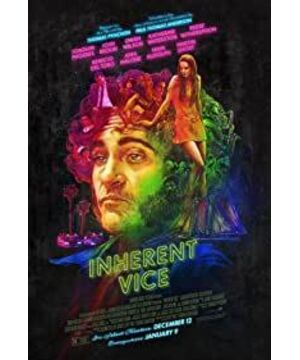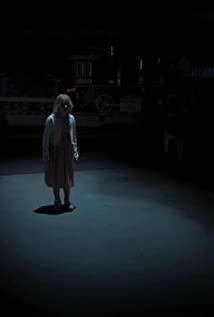The background of "The Evil of Nature" was in Nixon's reign. Reagan was the governor of California. In 1970, with the exhaustion of the 1960s, he shattered the wreath of "peace and love" and tossed all the hopes of the decade. live. Private detective Larry (Larry Doc Sportello) (played by Joaquin Phoenix Joaquin Phoenix) lives in a leisurely coastal suburban life, welcoming his ex-girlfriend Shasta Fei Hepworth (Shasta) in the trance of hallucinogenic drugs. Fay Hepworth (Katherine Waterston)'s sudden visit. This scene is very similar to the 1941 "Eagle of Malta" played by Mary Astor (Mary Astor) walking into the law firm of Sam Spade (Humphrey Bogart) For a moment, the exciting beginning, after that, the interlocking puzzle solving and progressive crime solving also began with the visit of a beautiful woman. But unlike Mary Astor's strong purpose-oriented lady, Shasta's motives are not clear, and she is an elusive role in the whole movie. She did not betray a fatal blow, and the Pandora’s Box opened did not detonate a vigorous disaster, but behind the marijuana mist, this is still a standard detective movie and a gangster movie. There are enchanting femme fatales, there are The intricately coiled mystery, there are puppets running in all directions, and all the elements of a typical genre. But why is "Nature Evil" so different and so unforgettable?
This film is adapted from Thomas Pynchon's 2009 novel of the same name. There is no doubt that Thomas Pynchon can stop at the crime type sales, it must be due to the influence of Raymond Chandler and Ross Macdonald in the last century, similar In novels like "Double Compensation," "Chinatown," and "Sleeping Beauty," they often have a perplexed but mission-conscious detective who wants to protect the trampled in society at all costs, but Pynchon is this one. The prototype is infused with new ideas and strength. Larry Doc Sportello in "The Evil of Nature" is a hippie who can no longer be a hippie, with long hair, drugs, sloppy, "non-mainstream", but he actually implicated a whole system of huge, dangerous organization shady, and behind this Carrying historical poison and trauma.
The opening of Shasta clarified that he had an affair with the Los Angeles real estate tycoon "Mickey" Wolfman (Eric Roberts), and speculated that his wife and lover were preparing to plot to kidnap her husband, and he might even be in danger. Shasta pleaded Doc helps her find out the truth of the matter. But does Doc have a choice? Since they ended their relationship, Doc seems to still love her. The arrogance of past sex and love is in sharp contrast to the depression of the shabby room at the moment. It is not so much that he is practicing the ideal role of a hippie, as he is still indulging in frustrated memories. middle. When Shasta appeared on the camera for the first time, the cloudy yellow backlight collided with Doc’s gloomy blue light, the shaky picture and Shasta’s overexposed profile. We would imagine whether this sudden visit would be Doc’s for a while. Hi after the dream in the second half. Because this series of shots are like siren lights—in fact, they are the earliest clues laid out in the movie. Doc can't figure out the clues, and we can't figure out the mind in the image itself.
Throughout the film, PTA always emphasizes the gap between "transient vision" and "physical existence". So what is the gap between "transient vision" and "physical existence"? In fact, when we are watching a movie, the characters appear in the space and time they are in. The characters appear in the park in the morning, in the meeting room of the morning office, at the lunch table at noon or in the bar at night. But in this movie, the appearance of so many characters is like a fast carousel slide, which makes people overwhelmed-Doc’s old enemy "Bigfoot" Bjorsen (Josh Brolin) makes his first appearance as a LAPD detective lieutenant. He even appeared in a TV commercial with a "hippie" explosion head to endorse the Channel View Estates real estate; once a drug addict musician Coy Harlington (Owen Wilson, Owen Wilson) first appeared from a photo of her wife ; To some extent, the real estate tycoon Mickey Wolfmann, who connected the whole movie in series, can only be seen from a newspaper picture for the first time; the killer Adrian Prussia (Peter McRobbie) Decoration) for the first time only appeared in the FBI picture file archive. The first time we came into contact with these characters was from TV, photos, newspapers, or archives. Some of these characters are just superficial, and some stay here for a while, and inadvertently lose any useful or useless clues. This unconventional introduction to the characters made Doc dizzy and forced him to write "No Hullucinating" in his notebook to remind himself to stay awake. And this close-up of the pen tip may also be another warning light-it seems to say that the identities of people and things here are constantly transforming, and the perspective is suspicious, just like paranoia, it is just another way to peek into the facts. .
In traditional detective novels, suspense is the magnet that attracts us into the story. It depends not only on solid narrative positive feedback, but also on deliberately set conspiracy points. On the one hand, the audience is pushed by the desired rhythm, on the other hand, it is also If it is not so, the suspense that is too simple and easy is too easy to make people tired. However, PTA may deliberately violate the classic detective film, repeatedly mixing up clues that have long been intertwined, and relentlessly exacerbating the chaos of the plot. All the ambitions to solve the mystery of "Nature is Evil" are eggs and stones. This embarrassment is like a dog chasing its own tail, getting close, but never holding it; everything trying to clarify a new character A raid, a jerky new character, a simple new sub-picture attempt will turn around in the plot; all vectors that want to find the main line and the secondary line will be added and subtracted from time to time and multiplied and divided by the built-in and external plots. fall. Therefore, it is painful for Hu Xuan to be caught in such a trap, but it is undeniable that PTA's "Nature is Evil" is the most faithful and credible adaptation of Pynchon's original work. We know that the fidelity of novels to movies has always been a nuisance, especially when dealing with original materials like "The Evil of Nature" whose story, plot, and character arc are not obvious. For a party of readers, the original work itself is a rhizome structure, and the ever-changing display of stories zigzags forward. This kind of "encyclopedia writing" is not necessarily suitable for all readers. There are many criss-cross plot clues in the novel, as well as sudden and sudden stops. The incident is not purposeful, or even irrelevant, which will greatly exceed the scope of attempts to adapt the film. The reason why PTA’s works is possible is if and only if it is also the miracle of editing, copying and pasting, cutting and dragging, and the "fragment" novel with thick cloth head is broken up again, maximizing the artificial imprint, and abandoning the traditional Explain the shots and cutscenes, leaving no buffering opportunities, jumping back and forth with fragments of images and sound tracks, crawling intermittently. In general, although it is impossible for the audience/reader to find a given scene, nor is it possible to reap the narrative pleasure of inheritance and transformation, this kind of unique narrative yarn ball has its own unique rhythmic tension. Add the gas, step on the brakes, and drive endlessly after bumping into the zigzag curve.
The best example of this rhythmic tension is the sudden appearance of the character Clancy Charlock (Michelle Sinclair) in Doc's office. Through their conversation, we learn that Clancy is Glen Charlock's younger sister, and he hopes Doc will find her to find the killer who killed his brother. And when the camera was on Clancy, this slightly erotic elevation angle shot gave her full and round breasts unobstructed, and it was invisibly open to give her character setting-a sexy, slutty, bold and aggressive Woman. Even when Doc sent her out, we still saw two tough guys waiting for her in the waiting seat. Combined with the previous lens projection on Clancy, we can speculate that they are obviously going to fly. But even if we succeeded in drawing Clancy's character portrait and behavior motivation, it would be a flash in the movie. In fact, in the novel, Doc has been following Clancy and her "friends" in an attempt to find clues to the killer, and Clancy is also the most important lead to lead the clues to the Las Vegas line. It may be due to budget, or it may be that the movie text cannot achieve the time and space convenience of the text text. PTA chose to delimit the scope and bind Clancy to the current Los Angeles, because Los Angeles is the gathering place for all the stories. If you join the Las Vegas scene for the sake of the fullness of the characters, not only will it not be able to balance the weight that this module should have from the part, but it will also not be able to give a useful plot push from the whole. The reason why the director removed the branch line in Las Vegas, leaving only the scene of Clancy in Doc's office is because once the audience gets used to the fragmented processing of the movie, they will find that only this combination can appreciate the current Doc. Confusion will not have heavy causal burden. Although this unreasonable sense of suspension sacrifices the audience's grasp of the narrative understanding, this sense of suspension not only requires the audience to absorb as much information as possible in the present, but also makes the audience doubtful and look forward to the future. So why does PTA rebel against linear narrative? In my opinion, on the one hand, it is a respect for the style of the original work, and on the other hand, it is a detailed re-engraving of the historical background where it is located.
During this period, social chaos and political turmoil, marijuana, tobacco and alcohol, heroin, cocaine, psychedelics, and laughter bombs, we followed Doc's investigation journey, confused and swaying to collage various information clues. The first second was still racking his brains, and the next second was laziness and depression. Doc's vacant personality is just like the middle-aged gangster "Master Governor" in the Coen Brothers' "Murder of Green Toe". Like "Master Governor", they are all puppets led by various characters. Such communication and dialogue quietly connect individuals with the political realm. Through Sortilege's narration, they further elaborated on American private enterprises and counter-culture. Force confrontation between organization, law and system, or mutual support between forces:
"If Golden Tusk can help its clients get rid of drug addiction, why sell them drugs while helping them get rid of drugs? Why bother to make them run back and forth? As long as the United States is still there, as long as the reality that needs to be avoided is still there , Golden Tusk can always get countless new customers."… "The dark history of land occupation in Los Angeles-for the construction of the Dodge Stadium, the Mexicans were driven out of the Chavaz Canyon by the family, and the Indians were forced to build the music center. To drive down Bunker Hill, Tariq’s hometown was razed in order to make way for the gorge view real estate."
The repeatedly mentioned "Golden Tusk" sailing ship has become a dark side of American history. It "smuggled during the period of slavery... it became a hawking tool when the blacks were fighting for liberation." During the Cold War, it became the secret weapon of various anti-communist conspiracies in the United States. It is also responsible for destroying the black revolutionary groups and the white hippie community, advancing and retreating with the dark side of American history. When the interest groups represented by the Golden Tusk sniff any profitable market, they are actually taking advantage of the inherently fragile spiritual pursuits of human beings. These oligarchs must always ensure that countless new customers come in to ensure that the economic laws continue to make money. Money, and the target group of these new customers is the people who have been smashed by the times. Los Angeles in the 1960s concealed too much American-style sin and nasty. At the end of the movie, the rich Los Angeles millionaire Crocker Fenway said to Doc that it seemed to come from the abyss of hell-"You people have already paid the rent for the first time. Despised."
Golden Tusk Headquarters, Topanga Canyon Building, Chryskylodon Nursing Home, Chick Planet Massage Parlor, etc. These solid concrete bricks and tiles are a symbol of naked status, power and control. These buildings contribute to the socio-political torrent of "Sexual Evil" Just like the bizarre shady behind the city and dam infrastructure in "Chinatown". Real estate, water rights, oil, cheap labor, all of these are theirs, and these rich and wealthy chaebols are taking advantage of the "evil nature" of human beings. The kind of impulse that arises from within and from all of us is self-destructive. "Inherent Vice" is also called "inherent defect" in the popular language of material, also known as "natural characteristic", "inherent defect" refers to the inherent defects of the goods or the material itself, and under normal circumstances it will also undergo qualitative changes and damage Or the natural characteristics of loss, fragile glass, easy to break eggs, easy to melt chocolate, the inherent defect of these goods is an inevitable loss, so the insurer is not liable for compensation. And hippies’ own shortcomings: greed, laziness, and selfishness. Their common shortcoming with the "Beat Generation" in the 1950s is that they value youth too much and always pursue novelty. Their attitude towards sex and death is not sound enough, so the ending is doomed. of.
Two contradictory worldviews are closely intertwined in the film: one is the anti-orthodox culture in the aftermath of the 1960s, the other is the conservatism revival of the 1970s, the other is the shameless and unkempt Doc, and the other is a suit and leather shoes, arranging your head. Bigfoot.
Uncle Phoenix, who collaborated with PTA for the second time, is two people in this movie and in 2012 "The Master". The appearance of Freddie Quell is in stark contrast with the randomness of Doc. In this movie, Uncle Phoenix wears a crumpled and heavy hairstyle and drags his dirty stinky feet. He is either drooping, lying down, or leaning on his side, but in fact shares a different historical shock like Freddie. Under the same existential crisis-one is the trance and boring after World War II and the other is the emptiness and loss after the Vietnam War. Is the Yuppies represented by Bigfoot better? They are generally highly educated and have a high level of knowledge and skills. Take a look at Doc’s prospective girlfriend Penny Kimball (played by Reese Witherspoon). She works in the government administration center and carries a briefcase all day long. , Looks hurrying in and out of hotels, office buildings, meeting rooms, waiting rooms, all day long sets of elegant professional fashion, but not willing to be hooked up by a dirty Doc? And Bigfoot, the depth of Bigfoot's pain not only made him grieve for losing his partner all day long, but also endured the cynicism of his colleagues. These people seem to be alive and clear, but they are not "understanding people" at all. They are blind people lingering in the muddy waters of the system.
What about Doc? On the contrary, the hippie Doc, who is often looked down upon, is the most clear (comparatively speaking).
In this regard, briefly research the English meaning of hippies. In terms of word formation, hippie in English is composed of hip+pie. The hip in the front part means "knowing and understanding", which means knowing in English, and the pie in the latter part means "people of..." , Which means of a person in English (same as pie in the words yuppie and yippie in English). Together they can be understood as "a person who understands", "a person who knows what is going on", or "a person who knows". The Chinese translation of "hippie" is a homophonic translation of the English word hippie, giving people the impression of joking, not serious and confused. In fact, the hippies are quite serious when it comes to resisting mainstream society and its values. The hippies “know” the society they live in—they call the American society in the 1960s a “pathological society”; the hippies “know” exactly what is happening around them—they I think I am "creating a new world, a world that is parallel to the old world but not on the same path." Every American citizen of that era had a sense of belonging. As a "understandable" hippie, he did not choose to be proficient in calculations, and was well versed in how to use various opportunities to maximize self-interest. On the contrary, all the hippies become "understandable" because they think they have insight into the madness and degeneration of modern American society and the blind obedience, confusion, confusion, and helplessness of modern people. Compared with them, the non-hippie people are unaware of this. The vast majority of people are still in the dark, either following the crowd blindly, or self-defeating and willing to fall. The hippies firmly believe that American society is dying and decayed. Knowing that it is meaningless to continue to live in this society, they decide to be a "understanding man" and escape from this society as soon as possible. Organize various anti-orthodox cultural fairs and activities.
But I mentioned above that "understanding or not" is a comparative concept. When the development of history has not moved in the direction expected by the enthusiastic liberals, everyone should not try to escape. The Vietnam War, racial issues, gender discrimination, economic crisis, environmental issues, etc. have put the imagination of the "great society" on the shelf and survived in name only. The so-called "New Frontier" does not see the "frontier". American society has entered a winter where all thoughts and ideals have been lost. The Eden time of the Summer of Love will have to endure the worst part of the long river of time.
When "Nature is Evil" depicts such a fragment: if Doc is a frontal close-up with all thoughts, then Bigfoot is a side close-up, because Doc and Bigfoot are the same type of person. When Bigfoot chewed the marijuana leaves in tears, Doc's eyes full of tears were his understanding of Bigfoot without words. We gradually realized that Bigfoot's tragic story involved the death of his partner-aversion to money supremacy, opposition Dehumanized techno-bureaucracy, hates hypocrisy and deception, and pursues self-innocence. But the same full of tears will also be because he is outnumbered, and nothing can provide eternal freedom, even drugs. Indeed, drugs provide them with a quick and effective shortcut to escape from the world and avoid troubles. Once the drug has passed, the user must return to the world and continue to face the cruel reality that he is unwilling to face but cannot avoid. At this moment, the hilarious Doc and Bigfoot are sober, but sober is painful, even if hilarious, they are exhausted.
In the film, the protagonist Doc and his ex-girlfriend Shasta have very few emotional scenes, and there are two very important scenes. One is that Doc and Shasta suffer from the lack of drugs to relieve their greed. They are all in a trance and soulless. They rushed in the rain to find marijuana under the guidance of the phantom board. This golden glow of memory drew a climax in the phone booth in the rain. It is the most hippie culture. The period of prosperity. And when Shasta returned to Doc’s house unknowingly after she disappeared one night, her naked carcass, teasing, confessing her treachery, next to the real estate tycoon, indulging in vanity and vanity, on the sofa. Go up and vent your desires with Doc, and all your hatreds and grievances will fall. The very rough sex scene at this moment presents not only Doc’s gloomy hatred, but also an important node in the collapse of the power allegory at this moment. All dominant and subordinate ideologies, and all shocking historical changes are now reconstructed in the tears and tears of Doc and Shasta. In sweat, in love and hate. "It doesn't mean we are together again," Shasta said. This is an account of everything after the dark journey.
There are also repeated occurrences of golden fangs sailboats in the movie. From the initial mirage-like model, I think of the sunset scene where Newland waited for Ellen to turn his head in "Age of Innocence"-the reflection on the water. The large clouds of clouds reflected red on the pier and red on his skin. Newland prayed: “If Alan turns around before the ship passes the lighthouse, he will go up and confess, he will be able to get rid of the shackles of society and embrace love that has been suppressed for too long.” The same two boats on the water, one is a bet full of hope, and the other is a chaotic clue, but the desire for intimacy in the two films is obvious. Although Newland did not wait for Alan to turn back, he took his love forever Living in my heart, and Coy can't wait to escape from the nursing home and go home to reunite with his wife is a rare and deepest moving moment in the movie.
But "this doesn't mean we are together again."
At the end of the film, the sincere love between Shasta and the California real estate tycoon ended but he did not return to Hippie Dock. He just sat in the car with Dock and looked confused as if he was still wandering in dreams, leaving everything right now. This symbolizes the prosperity and end of hippie culture, but we already have too many symbols, but the people in them often don't know the end. History does not leave a trace of everyone.
In the history after 1970, when Reagan's tsunami swept through everything in front of us, Mao's thoughts were no longer popular in the market. The Wall Street Journal defeated Xiaohongshu, and marginal supply economics replaced the power of the people. Those baby boomers who are fighting against the war are entering middle age, ready to be marginalized in the next wave. After the greedy solipsist in the 1980s, there was the X generation in the 1990s, or the slackers, who had an indifferent attitude towards the hippies of the 1960s and the yuppies of the 1980s.
Then what is the significance of opening up "Nature in Evil" again?
The meaning is that the 60s themselves are like shining parentheses. Perhaps it ends here, all lost, and disappeared into the darkness, but there is always a light that will emerge from the darkness, re-justifying the name of this era, for this Spiritual rectification.
View more about Inherent Vice reviews











